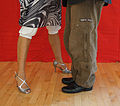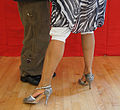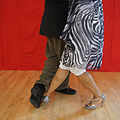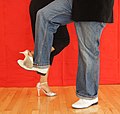Walking systems
Walking in a cross system is defined as the couple stepping simultaneously with their two right legs and stepping simultaneously with their two left legs. Walking in a parallel system is defined as the couple stepping simultaneously with the leader's right and follower's left leg, and then with the leader's left and the follower's right leg. When dancers are facing each other, the cross system results in an anti-mirror effect. For this reason, in ballroom tango cross system is never used unless both dancers are facing the same direction. Argentine tango, however, makes extensive use of the cross system with dancers facing each other. In Argentine tango, the leader can change his weight from one foot to another while the follower's weight remains unchanged; this is the simplest method of changing from parallel system to cross system or vice versa. By contrast in ballroom tango, a weight change by one partner leads to an automatic weight change by the other.
The cross system and parallel system walk nomenclature originated with the Naveira/Salas "Investigation Group." Early on, they used 'even/uneven' to describe the arrangement of legs in the walk or turn. By the mid-1990s, they began using 'parallel/crossed' and later 'normal/crossed'. The process of changing from the parallel system to cross system (or vice versa) by having the leader change weight without the follower changing weight (or vice versa) is named contrapaso, or "contra-step". This change can be made off or on the normal beat.
| Spanish | English | Description – Walk elements | Image |
|---|
| Sistema paralelo | Parallel walk | The leader steps with his left leg forward, the follower steps with her right leg back; the leader steps with his right leg forward and the follower with her left leg back |  |
| Sistema cruzado | Cross walk | The leader steps with his right leg forward, the follower steps with her right leg back; the leader steps with his left leg forward and the follower with her left leg back |  |
| Contrapaso | Weight change | Weight change used to switch between parallel and cross system of walking. | |
| Americana | Promenade (sweetheart walk) | Walking by facing the same direction and stepping forward. This resembles a walk in the park by sweethearts (except they may hold their hands together whereas in tango the embrace is preserved). This walk can be initiated by salida Americana. |  |
|
Eight count basic (8CB)
Basic step (paso básico, basico cuadrado y cruzado) is used for education purposes and almost never danced as a basic step of tango. For this reason it is sometimes called pejoratively academic basic. Nevertheless, it contains basic elements of the dance. Also, it serves a purpose of "establishing notation" to more complex tango elements. Basic step (eight count basic, 8CB) is composed of back step, side step, cross for the lady (leader steps outside of his partner with his right leg), forward step, and side step. Basic steps can also be divided into four phases: salida – position 1 and 2 and transition from position 2 to position 3; caminata (position 3 and 4), cross (position 5), and resolution (positions 6,7,8). There are variants of the basic step.
| Spanish | English | Description – Basic step (8 count basic) | Image |
|---|
| Position cero | Position 0 (tango close) | Collection. Feet closed. See also collect | |
| Uno (salida atrás, primera) | Position 1 | Back step, part of salida (not used in social dancing) |  |
| Dos (salida costado, apertura, segunda) | Position 2 | Side step, open step, part of salida or beginning of the salida | 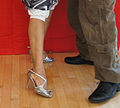 |
| Tres | Position 3 | Salida simple (basico cuadrado) or crossed (basico cruzado); beginning of the basic step walk. |  |
| Cuatro (caminata) | Position 4 | Basic step walk. | |
| Cinco, cruce | Position 5 (cross) | Cross. See also cross. |  |
| Seis | Position 6 | Walk, part of resolution. |  |
| Siete | Position 7 | Side step to right, open step, part of resolution. |  |
| Ocho | Position 8 | Weight change, part of resolution. See also cadence. | |
|
Baldosa (tile) or cuadrado (square) is a six-step figure similar to the ballroom box step except the man starts with his right foot, then steps back, side, forward, forward, side, feet together; the baldosa is the basic step of milonga. This baldosa is similar to eight count basic with the exception of the cross.
Some Argentine tango teachers teach complex figures but break them down into simpler parts. Subsequently, they teach students how to improvise their own figures. Beginner classes may include caminada – combination of caminar (walk), cross, and ochos. The beginning part of a figure, its starting-point, is called salida (exit or beginning – as in "beginning of a journey"). The end part of a figure is called resolución. Combination of the salida, a walk, the cross of the lady and the resolución is called basic step (paso basico, la base, salida simple).
Thus, an Argentine tango figure is the pattern of salida, combination of elements, and resolución. This makes for flexible, ever-changing patterns. It gives leader an exceptional opportunity to improvise, and in part makes the Argentine tango unique in the dance world.































































